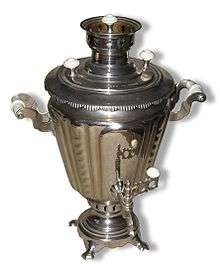Russian tea culture
Tea is a part of Russian culture. Russian tea is brewed and can be served sweet, and hot or cold.
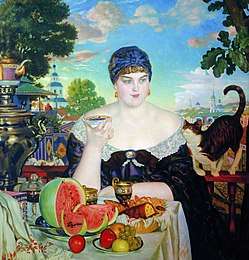
History
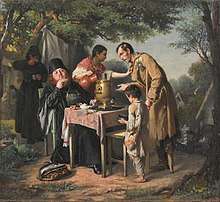
Already in 1567 Russian people came in contact with tea when the Cossack Atamans Petrov and Yalyshev visited China.[1] Tea has a rich and varied history in Russia. Due in part to Russia's cold northern climate, it is today considered the de facto national beverage,[2] one of the most popular beverages in the country,[3] and is closely associated with traditional Russian culture. It was traditionally taken at afternoon tea, but has since spread as an all day drink, especially at the end of meals, served with dessert. An important aspect of the Russian tea culture is the ubiquitous Russian tea brewing device known as a samovar, which has become a symbol of hospitality and comfort.
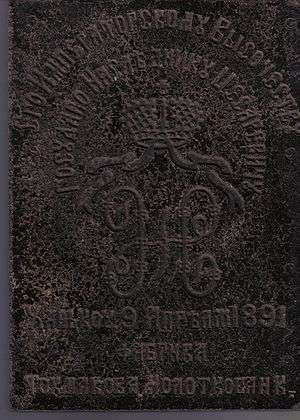
From the year 1638 tea culture accelerated in Russia when a Mongolian ruler donated to Tsar Michael I four poods (65–70 kg) of tea.[4] According to Jeremiah Curtin,[5] it was possibly in 1636[6] that Vassili Starkov was sent as envoy to the Altyn Khan. As a gift to the Tsar, he was given 250 pounds of tea. Starkov at first refused, seeing no use for a load of dead leaves, but the Khan insisted. Thus was tea introduced to Russia. In 1679, Russia concluded a treaty on regular tea supplies from China via camel caravan in exchange for furs.[4] The Chinese ambassador to Moscow made a gift of several chests of tea to Alexis I.[7] However, the difficult trade route made the cost of tea extremely high, so that the beverage became available only to royalty and the very wealthy of Russia.[7] In 1689, the Treaty of Nerchinsk was signed that formalized Russia's sovereignty over Siberia, and also marked the creation of the Tea Road that traders used between Russia and China.
Between the Treaty of Nerchinsk and the Treaty of Kyakhta (1727), Russia would increase its caravans going to China for tea, but only through state dealers. In 1706, Peter the Great made it illegal for any merchants to trade in Beijing. In 1786, Catherine the Great re-established regular imports of tea. By the time of Catherine's death in 1796, Russia was importing more than 3 million pounds by camel caravan in the form of loose tea and tea bricks, enough tea to considerably lower the price so that middle and lower class Russians could afford the beverage.[8]
The peak year for the Kiakhta tea trade was in 1824, and the peak year for the tea caravans was 1860. From then, they started to decline when the first leg of the Trans-Siberian Railway was completed in 1880. Faster train service allowed for tea to be imported from nearly a year and a half to eventually just over a week.[9] The decline in Chinese tea in the mid 19th century in turn meant that Russia began to import more tea from Odessa, and London. By 1905, horse drawn tea transport had ended, and by 1925 caravan as the sole means of transport for tea had ended.[10] In 2002, Russia imported some 162,000 metric tons of tea.[11]
By the late 19th century, Wissotzky Tea had become the largest tea firm in the Russian Empire. By the early 20th century, Wissotzky was the largest tea manufacturer in the world.[12]
Production

By the end of the 18th century, tea prices had moderately declined. The first local tea plant was set in Nikitsk botanical gardens in 1814, while the first industrial tea plantation was established in 1885.[4] The tea industry did not take off until World War I, and greatly expanded following World War II. However, by the mid 1990s, tea production came to a standstill. Today, the main area in Russia for tea production is in the vicinity of Sochi.
Varieties
Traditionally, black tea is the most common tea in Russia, but green tea is becoming more popular.
Traditional tea in Russia includes the traditional type known as Russian Caravan as it was originally imported from China via camel caravan. As the trip was very long, usually taking as long as sixteen to eighteen months, the tea acquired its distinctive smoky flavor from the caravan's campfires. Today, this tea is often given its smoky flavor after fermentation or is a keemun or a "black or oolong from southern China or Formosa (Taiwan) with a hint of smoky Lapsang Souchong or Tarry Souchong." [13]
Brewing
A notable feature of Russian tea culture is the two-step brewing process. First, tea concentrate called zavarka (Russian: заварка) is prepared: a quantity of dry tea sufficient for several persons is brewed in a small teapot. Then, each person pours some quantity of this concentrate into the cup and mixes it with hot water; thus, one can make one's tea as strong as one wants, according to one's taste. Sugar, lemon, honey or jam can then be added freely.
Tea culture
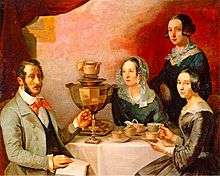
According to William Pokhlyobkin, tea in Russia was not regarded as a self-dependent beverage; thus, even the affluent classes adorned it with a jam, syrup, cakes, cookies, candies, lemon and other sweets. This is similar to the archaic idiom "чай да сахар" (tea and sugar, translit. chay da sakhar). The Russian language utilizes some memes pertaining to tea consumption, including "чайку-с?" ("some tea?" in an archaic manner, translit. chayku s), used by the pre-Revolutionary attendants. The others are "гонять чаи" (chase the teas, i.e. drinking the tea for overly prolonged periods; translit. gonyat' chaii) and "побаловаться чайком" (indulging in tea, translit. pobalovat'sya chaykom). Tea was made a significant element of cultural life by the literati of the Karamzinian circle.[14] By the mid-19th century tea had won over the town class, the merchants and the petty bourgeoisie.[14] This is reflected in the dramas of Alexander Ostrovsky. Since Ostrovsky's time, the duration of time and the amount of tea consumed have appreciated.[14] Alexander Pushkin in Eugene Onegin displayed the role of tea in establishing romantic relations:
- Of single boredom, right away
- They speak–but in a cunning way.
- They call him to their samovar–
- None but Dunya will pour the tea;
- They whisper to her: "Dunya, see!"
- And then produce her sweet guitar.
- O Christ! She then begins to cheep:
- "Come see me in my golden keep!"
In the Soviet period, tea-drinking was extremely popular in the daily life of office workers (female secretaries, laboratory assistants, etc.). Tea brands of the time were nicknamed "the brooms" (Georgian) and "the tea with an elephant" (Indian).[14] Tea was an immutable element of kitchen life among the intelligentsia in 1960s-'70s.[14]
In pre-Revolutionary Russia there was a joke "что после чаю следует?" ('what follows after tea?', translit. chto poslye chayu slyeduyet) with the correct answer being "the resurrection of the dead" from the Nicene Creed.[14] This is based on the word "чаю" (chayu), the homograph designating formerly "I expect" ("look for" in the creed) and the genitive case of the word "tea", still in use.
Within Russia, tea preparation differs, but usually includes lemon, and sugar or jam. Tea sachets are widely popular, but when a teapot is used it is very common to make a strong brew, then pour some into a cup and top it with hot or boiling water, adding milk and sugar afterwards.
In the 19th century, Russians drank their tea with a cube of sugar (from sugarloaf) held between their teeth.[15] The tradition still exists today.[16]
Tea is very popular in Russian prisons. Traditional mind-altering substances such as alcohol are typically prohibited, and very high concentrations, called chifir are used as a substitute.[17]
Traditional forms of Russian tea ware include the Russian tea brewing urn called a samovar, the Lomonosov tea sets adorned with a cobalt blue net design and 22 karat gold, and traditional Russian tea glass holders.
"Russian Tea" in other countries
United States
There is a beverage called "Russian Tea" which likely originated in America. This drink is especially popular in the Southeastern United States where is it traditionally served at social events during Advent and Christmastide. Recipes vary, but the most common ingredients are loose black tea, orange juice (or orange peel), cinnamon, and cloves; some recipes use instant tea powder. Other juices such as lemon and pineapple are sometimes called for. Cream may also be added when serving. A homemade 'instant' variety, often using Tang, has become a popular stocking stuffer in recent decades.[18]
The drink is served hot and often an evening or after-meal beverage. However, iced versions are sometimes offered with meals at cafés.
Despite the name, "Russian Tea" probably has no link to its namesake. References to "Russian Tea" and instructions have been found in American newspapers and cookbooks dating as early as the 1880s.[18]
Japan
In Japan, the term "Russian tea" is used to refer specifically to the act of having black tea with a spoonful of jam, whether added into the cup or placed on the tongue before drinking. The typical choice is strawberry jam, but not exclusively so. [19]
Notes
- "Russian Tea History". www.apollotea.com. Retrieved 2019-05-28.
- Mack, Glenn (2005). Food Culture in Russia and Central Asia. Westport: Greenwood Press. ISBN 0-313-32773-4.
- Martinchik AN, Baturin AK, Martinchik EA, Tutel'ian VA (2005). "[Tea and coffee consumption among Russian population]". Vopr Pitan (in Russian). 74 (3): 42–6. PMID 16044841.
- Great Soviet Encyclopedia. Советская энциклопедия. 1978. pp. vol. 29, p. 11.
- Jeremiah Curtin, A Journey to Southern Siberia, 1909, Chapter one
- Basil Dymytryshyn, Russia's Conquest of Siberia: A Documentary Record,1985,volume one, document 48 (he was an envoy that year, but the tea may have been given on a later visit to the Khan)
- "Tea Time in Russia: Russian Life". Retrieved 2008-04-22.
- O'connor, Sharon (1997). Afternoon Tea Serenade. City: Menus & Music Production. ISBN 1-883914-18-3.
- Weinberg, Bennett (2001). The World of Caffeine. New York: Routledge. ISBN 0-415-92722-6.
- Avery, Martha (2003). The Tea Road. Beijing: China Intercontinental Press. ISBN 7-5085-0380-5.
- Jolliffe, Lee (2007). Tea and Tourism: Tourists, Traditions, and Transformations. Clevedon England: Channel View Publications. ISBN 978-1-84541-057-5.
- Merchants to Multinationals: British Trading Companies in the Nineteenth and Twentieth Centuries, Geoffrey Jones, Oxford University Press, 2000
- Pettigrew, Jane (1999). The Tea Companion. City: Viking Australia. ISBN 0-670-88401-4.
- Знание - сила, 9/2006, p. 105; ISSN 0130-1640
- Perry, Sara (2001). The New Tea Book. San Francisco: Chronicle Books. ISBN 0-8118-3053-5.
- "Russian Tea HOWTO" (PDF). 2002-04-01. Archived from the original (PDF) on 2006-11-27. Retrieved 2008-04-26.
- "Russian Tea: America's choice in outer space under a Soviet name". Yesterdish: Rescuing America's Lost Recipes. 22 November 2013. Retrieved 9 October 2018.
- https://dic.pixiv.net/a/%E3%83%AD%E3%82%B7%E3%82%A2%E3%83%B3%E3%83%86%E3%82%A3%E3%83%BC
